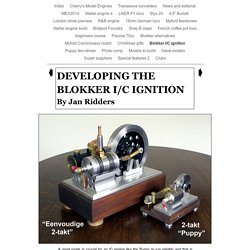

Interchangeable parts. Ford assembly line, 1913.

The magneto was the first to be assembled. The concept of interchangeability was crucial to the introduction of the assembly line at the beginning of the 20th century, and has become an important element of some modern manufacturing but is missing from other important industries. Methods for industrial production of interchangeable parts in the United States were first developed in the nineteenth century.
The term American system of manufacturing was sometimes applied to them at the time, in distinction from earlier methods. Within a few decades such methods were in use in various countries, so American system is now a term of historical reference rather than current industrial nomenclature. First Use[edit] Evidence of the use of interchangeable parts can be traced back over two thousand years to Carthage in the First Punic War. Before the 18th century, devices such as guns were made one at a time by gunsmiths, and each gun was unique.
Implementation[edit] The Factory Floor, Part 1 of 4:The Quotation (or, How to Make a BOM) This month, I will be teaching a few MIT Media Lab graduate students and doing a bit of a “geek tour” of Shenzhen – we will visit several factories and live among the electronic markets to facilitate new directions and expand horizons in the students’ hardware-oriented research projects.

As part of the course, they will learn how to scale up their research utilizing the China manufacturing ecosystem. These lessons may also be useful for Makers looking to bootstrap a product in moderate volumes (hundreds to thousands of units). I will share some tips and insights from the course in four posts over the next month covering: Getting a quotation: documentation standards (how to make a BOM) Process optimization: design for manufacturing and test jigs Industrial design for startups: guerrilla engineering on a shoestring budget How to pick a factory: building and maintaining partnerships Part 1 of 4: The Quotation (or, How to Make a BOM) Let’s consider a simple case study.
Approved manufacturers. Cleaning Parts Cost Effectively. Article From: 3/18/2013 Production Machining, Chris Felix , Senior Editor Click Image to Enlarge After machining, most parts are coated with some residue consisting of either aqueous or oil-based cutting fluids and swarf.

This comparison shows parts before cleaning (top) and after cleaning in an iFP Kleen Power vacuum parts washer. The iFP Kleen Power vacuum parts washer offers an optional automation system for moving parts in and out of the chamber. Once the chamber door is sealed, a pump pulls the air out of the chamber to create a vacuum and the chamber is filled with the appropriate solvent. Successful manufacturers understand the importance of improving part-making processes to increase productivity and, therefore, be more competitive and profitable.
In the case of parts with simple geometry, manufactured using water-soluble coolant, a basic aqueous solution bath or rinse may be all that is necessary. Modern History of Wire Rope. Modern History of Wire Rope by Donald Sayenga It wasn't until recent history (the 1600-1700s) that most of the technical breakthroughs in the modern history of wire rope were achieved in Europe.

This was followed by a remarkable 40-year period, between 1849-89, when a majority of the basic forms of wire rope still in use today all over the world were devised in the United States. Early German and English Ropes The first operative wire ropes of the modern era, employed in vertical shafts as hoisting cables in the Harz Mountain silver mines of Germany from 1834 to 1854, were not very complicated inventions. Three lengths of wrought-iron wire, all the same size, were twisted around each other by hand to make a strand. These handmade ropes, known as Albert Ropes (after William Albert, the Harz mining official who pioneered the practice) were not very flexible because the wires were relatively large and stiff. Smith soon left England for California and the Gold Rush. A.S. Gears- Gear Efficiency. Introduction Important Note: The equations used are mainly derived from the technical information provided in the SDP/SI technical library see links below.

I recommend that for serious work the linked information is more suitable. The efficiency of a gear system is simple calculated as the [output shaft power /Input shaft power ].100 %. LEGO Great Ball Contraption (GBC) Layout 2012.9. Possible to make/grind/polish flat surfaces manually? Blokker I/C ignition. A good spark is crucial for an IC engine like the Puppy to run reliably and that is often a headache for mechanical orientated model builders for various reasons.

Lack of knowledge and experience is one cause but also dimensions, availability, the price, the complexity of the systems or components can all be obstacles. I myself belong also to this category of model builders and I have been wrestling with this problem for as long as I have made IC model engines. My ideal system should meet the following conditions:1. The spark energy must be sufficient to ignite the gas mix reliably at the prevailing compression but also be safe to touch in all circumstances. That means that the high tension current may not exceed 2 mili-amperes.2. Some alternatives 1. In fact, this is a high tension transformer with a short and thick primary coil and a very long and thin secondary coil. (‘points’) that is driven by a cam.
The sparks are weak or not at all present then and they become very hot. 2. 3. 3.